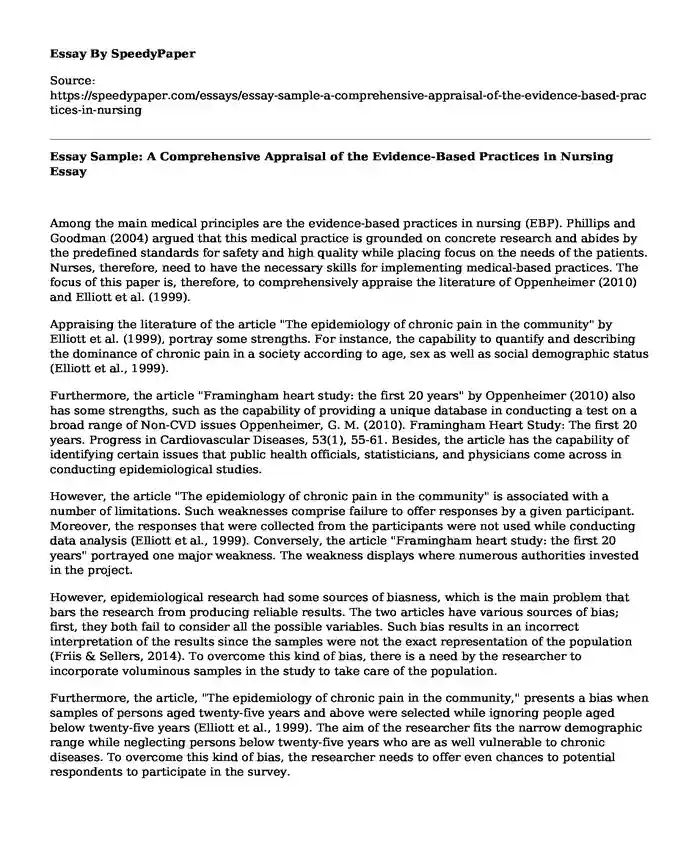Among the main medical principles are the evidence-based practices in nursing (EBP). Phillips and Goodman (2004) argued that this medical practice is grounded on concrete research and abides by the predefined standards for safety and high quality while placing focus on the needs of the patients. Nurses, therefore, need to have the necessary skills for implementing medical-based practices. The focus of this paper is, therefore, to comprehensively appraise the literature of Oppenheimer (2010) and Elliott et al. (1999).
Appraising the literature of the article "The epidemiology of chronic pain in the community" by Elliott et al. (1999), portray some strengths. For instance, the capability to quantify and describing the dominance of chronic pain in a society according to age, sex as well as social demographic status (Elliott et al., 1999).
Furthermore, the article "Framingham heart study: the first 20 years" by Oppenheimer (2010) also has some strengths, such as the capability of providing a unique database in conducting a test on a broad range of Non-CVD issues Oppenheimer, G. M. (2010). Framingham Heart Study: The first 20 years. Progress in Cardiovascular Diseases, 53(1), 55-61. Besides, the article has the capability of identifying certain issues that public health officials, statisticians, and physicians come across in conducting epidemiological studies.
However, the article "The epidemiology of chronic pain in the community" is associated with a number of limitations. Such weaknesses comprise failure to offer responses by a given participant. Moreover, the responses that were collected from the participants were not used while conducting data analysis (Elliott et al., 1999). Conversely, the article "Framingham heart study: the first 20 years" portrayed one major weakness. The weakness displays where numerous authorities invested in the project.
However, epidemiological research had some sources of biasness, which is the main problem that bars the research from producing reliable results. The two articles have various sources of bias; first, they both fail to consider all the possible variables. Such bias results in an incorrect interpretation of the results since the samples were not the exact representation of the population (Friis & Sellers, 2014). To overcome this kind of bias, there is a need by the researcher to incorporate voluminous samples in the study to take care of the population.
Furthermore, the article, "The epidemiology of chronic pain in the community," presents a bias when samples of persons aged twenty-five years and above were selected while ignoring people aged below twenty-five years (Elliott et al., 1999). The aim of the researcher fits the narrow demographic range while neglecting persons below twenty-five years who are as well vulnerable to chronic diseases. To overcome this kind of bias, the researcher needs to offer even chances to potential respondents to participate in the survey.
Moreover, the article "Framingham heart study: the first 20 years" shows bias from the usage of the self-selected cohort as a technique of data collection (Oppenheimer, 2010). Such a move might lead to an unbiased estimation of the incidence and prevalence in the research. To overcome this, the author needed to have used a collective data collection approach to offer equal chances for every part.
It is worth noting that various confounding variables might impact the research of the study (World Health Organization, 2011). For instance, the type of food consumption is a confounding bias that might influence the course and nature of chronic pain. Moreover, whether and geographical location is a confounding variable that might impact the result of the research study.
Conclusively, evidence-based practice is a fundamental requirement for any NDP-prepared nurse. The appraisal of the literature of Oppenheimer (2010) and Elliott et al. (1999) shows some and strengths and weaknesses that need to be adjusted to come up with a comprehensive result. Moreover, it is worth noting the influence of confounding variables on the research results. Such variables should thus be taken into consideration to help balance and hence come up with accurate research results.
References
Elliott, A. M., Smith, B. H., Penny, K., Smith, W. C., & Chambers, W. A. (1999). The epidemiology of chronic pain in the community. The Lancet, 354(9186), 1248-1252.
Friis, R. H., & Sellers, T. A. (2014). Epidemiology for public health practice (5th ed.). Sudbury, MA: Jones & Bartlett.
Oppenheimer, G. M. (2010). Framingham Heart Study: The first 20 years. Progress in Cardiovascular Diseases, 53(1), 55-61.
Phillips, C. V., & Goodman, K. J. (2004). The missed lessons of Sir Austin Bradford Hill. Epidemiologic Perspectives & Innovations, 1(3). Retrieved from http://www.biomedcentral.com/1742-5573/1/3
World Health Organization. (2011). Social determinants of health. Retrieved from http://www.who.int/social_determinants/en/
Cite this page
Essay Sample: A Comprehensive Appraisal of the Evidence-Based Practices in Nursing. (2023, May 01). Retrieved from https://speedypaper.net/essays/essay-sample-a-comprehensive-appraisal-of-the-evidence-based-practices-in-nursing
Request Removal
If you are the original author of this essay and no longer wish to have it published on the SpeedyPaper website, please click below to request its removal:
- Mona Lisa
- Library Cards - Free Essay with the Advertisement Analysis
- Career Essay Sample with Reflection on Received 360 Degree Feedback
- Free Essay Sample on Soil Improvement Techniques
- Essay Example on Impact of Healthcare Delivery Systems
- Free Essay Answering the Question: What Are the Effects of Privatized Education?
- Essay Example on Comparison and Contrast of Foreigner and Moana
Popular categories





